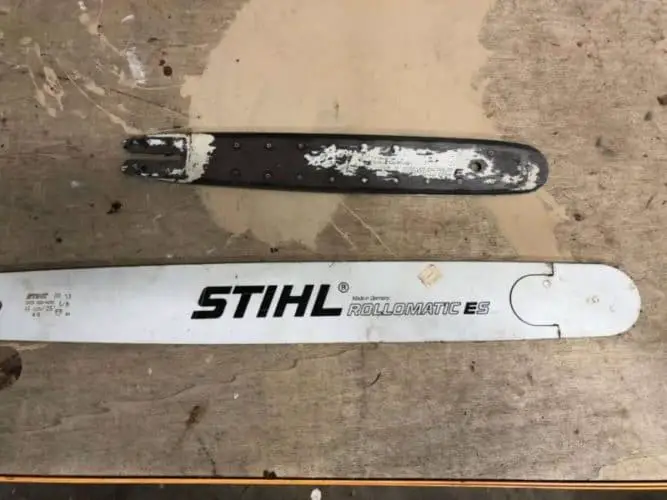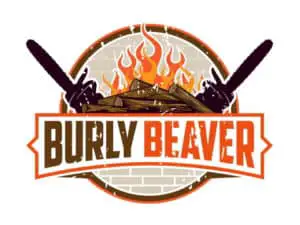A chain rapidly spinning to cut through a log can build up a lot of friction. Bar and chain oil can help with this friction but even with this, should a chainsaw blade get hot?
The chainsaw blade should not get very hot and should definitely not smoke. If it does, it’s likely that your chainsaw is out of bar and chain oil or you’re using the wrong sized chain or you’re cutting with a dull chain.
In the rest of this post, we’re going to talk about 4 things having to do with chainsaws and heat. That’s a lot to cover so we better get started.
- Is It Normal For a Chainsaw Bar/Chain to Get Hot?
- Why is My Chainsaw Blade Smoking?
- How do I Know if My Chainsaw Bar/Chain is Bad?
- Can Chainsaws Start Fires?
- Wrap-Up
Is It Normal For a Chainsaw Bar/Chain to Get Hot?

Using a chainsaw produces a lot of friction, but there are systems in place to prevent this friction. If these systems fail or you’re using the wrong equipment, it can cause the bar and chain to build up a lot of friction and heat.
So, let’s go into each thing and talk about why it causes friction and how to fix it.
Improper Lubrication
The most common reason why your chain/chainsaw is producing more heat than it should is that you’ve run out of bar and chain oil.
Bar and chain oil runs out of the oil tank directly into the bar track. It lubricates the chain as it runs through the bar track to prevent friction from building up.
Without this lubricant, friction can build up in your chain and bar track which can damage your bar, chain, and saw.
If you find that your chain is building up a lot of heat, smoking, or the motor is having a hard time cutting, check your oil tank to make sure that you haven’t run out.
As a general rule of thumb, check your oil tank every time you refill your fuel tank, sharpen your chain, or stop cutting.
If your oil tank is full but it doesn’t seem like your chain is getting oil, your oiler might not be working. Check out our other post to diagnose and fix this problem.
Wrong Sized Chain
Another reason why your chainsaw may be producing more heat than usual is that you are trying to cut with the wrong sized chain.
Using a chain that’s too large will rub excessively on the inside of the bar track and create extra friction in your chainsaw.
Using a chain that is too small will wobble within the bar track which can cause extra wear and friction on your bar.
If you’re not sure if you have the right-sized chain it’s pretty easy to check. We have another article dedicated to three simple ways to measure your chainsaw chain.
Dull Chain
Last but not least, your chainsaw blade could bet getting hot because you’re trying to cut with a dull chain.
Cutting with a dull chain means you’re basically grinding the blade into the log without it moving through. This will build up heat in the log, chain, and bar.
Making sure your chain is sharp is very easy fix to this. As a general rule of thumb, give your chain a quick sharpen between every other fuel tank used.
To tell if your chain is sharp, take a quick look at the sawdust produced from your chain. If there are defined chunks of wood in your sawdust, then your chain is sharp. If the sawdust is closer to being fine dust, then your saw is on the dull side and needs to be sharpened.
Sharpening a chain with a file guide is an easy and portable way to sharpen your blade while you’re out on your adventure. We have an article dedicated to explaining file guides and how to use them, check it out!
Why is My Chainsaw Blade Smoking?

A smoking chainsaw is defintely not normal for chainsaw operation. If your chainsaw is smoking then you need to stop working and fix the problem.
There are two main reasons why your chainsaw is smoking: problems with your bar/chain and problems with your fuel.
Bar and Chain Problems
The bar and chain problems that cause your saw to smoke are the same as the things that cause your bar and chain to heat up. Smoke indicates heat so it makes sense.
Let’s go over these issues again.
The most likely problem is that your chainsaw is low or out of bar and chain oil. This prevents the friction from building up to the point of smoking.
Just check the level of your bar and chain oil and add more if needed.
Next, check to make sure your chainsaw chain is the right size for your chainsaw bar. You can do this by checking the bar information stamp and comparing the measurements to your chain. If it’s not the right size it will rub and cause a lot of friction and possibly even smoke.
For better info on how to measure your chainsaw chain check out this post all about it.
Lastly, your chainsaw could start smoking because you’re trying to cut with a dull chain. This will cause extra friction which could cause smoke.
Check your chain for sharpness or give it a quick run with a file guide to sharpen it up.
A quick recap on what to check if your chainsaw is smoking. Check your bar and chain oil, check your chain to make sure it’s the right size for your bar, check the sharpness of your chain.
If none of those things are the problem, then you may have an issue with your fuel.
Fuel Problems
There are three things that could happen to your fuel to cause your chainsaw to smoke.
First, the fuel you’re using could be the wrong mix of fuel and oil. Chainsaw fuel isn’t just straight fuel. It’s a mix of fuel and engine oil and each chainsaw has a specific ratio it uses.
You can find the exact ratio in the chainsaw user manual or by searching your chainsaw manufacturers website.
Second, your fuel could be contaminated with water. If you worked in the rain or your chainsaw was exposed to water, then your fuel tank could have gotten water in it.
If you run your chainsaw with water in the fuel it can cause your chainsaw to smoke. If you think your fuel could have been exposed to water, drain your fuel tank and replace it with some fresh, water-free fuel.
Lastly, your fuel could be contaminated with other stuff like dirt, sawdust, etc… If you leave your fuel container close to you while you’re cutting, you could get sawdust or dirt kicked into it.
Check your fuel supply for debris and replace the fuel in your chainsaw if you think this might be the problem.
That was just a quick overview of what could cause your chainsaw to smoke. If you want some more info, we’ve got an entire article dedicated to smoking chainsaws.
How Do I Know if My Chainsaw Bar/Chain is Bad?

Chainsaw bars and chains can take a lot of wear and tear. The trick is to know when that wear is too much.
Damage and Wear to Chainsaw Bar
Damage to a chainsaw bar can come in many different ways.
Over time, your bar track will wear out both the depth and width. To check the depth, use your gauge tool and make sure your bar doesn’t drop lower than a certain point.
For the width, check to see if your chain wobbles back and forth within the bar track. If it does, your bar track is getting worn out.
Next, check your bar and bar track for any damage. Check to see if your bar is bent by laying it on a flat surface. This will make it easy to see bends.
Then, look down your bar track to check for pinches and burrs.
The last thing you need to look for is damage to the nose sprocket. Look for bent or missing teeth or a nose sprocket that doesn’t spin easily.
These are all the things to check on your bar track and bar. But, this is just a really quick overview.
For a super in-depth explanation on how to check for all of the things we talked about and more information about chainsaw bar wear, check out our other article dedicated to just that.
Damage and Wear to Chain
Chains can be used for a long time without needing to be replaced as long as you take good care of them.
However, some things require you to replace your chiansaw chain.
A pretty easy thing to spot that indicates your chain needs replaced is missing or broken cutters.
All you have to do is to give your chain a once over to make sure you’re not missing any cutters.
If you’ve used and sharpened your chain many times, then you need to check the sharpening marks on your chains’ cutters. A chainsaw can only be sharpened so much before it loses its integrity.
The sharpening marks look like this:

If your chain is close to or below these marks then you need to replace your chain.
In addition to these wear marks, if you hit any of the three chain killers then you need to carefully inspect your chain for damage and maybe replace it.
These chain killers are: hitting nails or metal, cutting ice, and hitting dirt or rocks.
We’ve got an article about when to sharpen and replace your chainsaw if you’re looking for some more details.
Can Chainsaws Start Fires?
The answer to this question depends widely on the climate where you’re cutting. If you have plenty of humidity in the air, then starting fires with your saw isn’t going to be a problem.
However, if you live somewhere that is very dry and/or has wildfire risk, such as the western United States, or you’re in the middle of a drought, it is possible that your chainsaw could start a fire.
With very dry sawdust and little air humidity, just the heat from the chainsaw blade or the exhaust port could be enough to start a fire.
It is also more likely to happen if you have an older chainsaw, 25 years or more. Modern chainsaws have more features in place to help prevent this heat from building up.
There are a few things you can do in the operation of your saw to help prevent the likelihood of starting a fire.
- Let your saw cool down before fueling
- Don’t start your saw directly next to your fuel container
- Be aware of where the exhaust port is and keep it away from dry tinder
- Don’t place a hot saw down on dry sawdust
- Avoid cutting into metal or anything that could cause sparks
- Never smoke or have open flame while operating a chainsaw
Again, if you live and operate somewhere that has higher humidity, then this isn’t going to be a problem for you. But, it’s always good to be aware of the risks.
Wrap-Up
We threw a lot of information at you in this article but hopefully, we answered any questions you had about chainsaw building up heat.
Let’s make a quick list of what to check when it comes to chainsaws and heat.
- Check your chainsaw bar and chain for excessive wear and damage.
- Regularly check your bar and chain oil while operating
- Check your chain for sharpness
- Ensure you’re using the right-sized chain
- Make sure you’re using the right fuel ratio
- Make sure your fuel is not contaminated by water or dirt
The main takeaway from all those words: know your tools and how to use them safely.
After all, knowledge is power!
